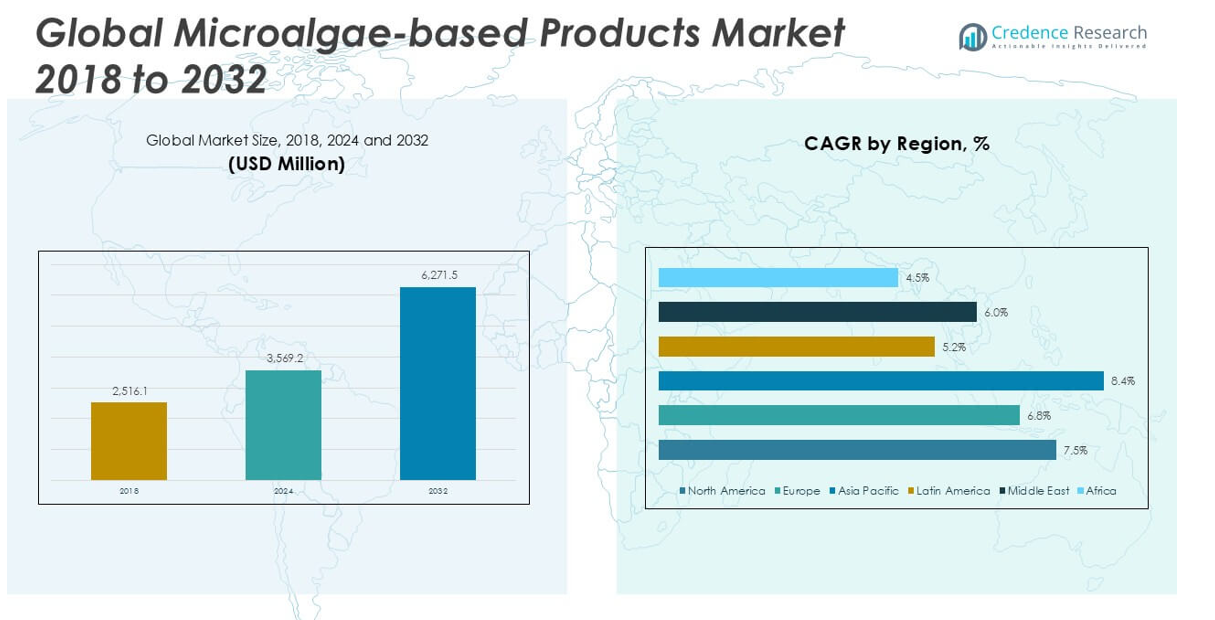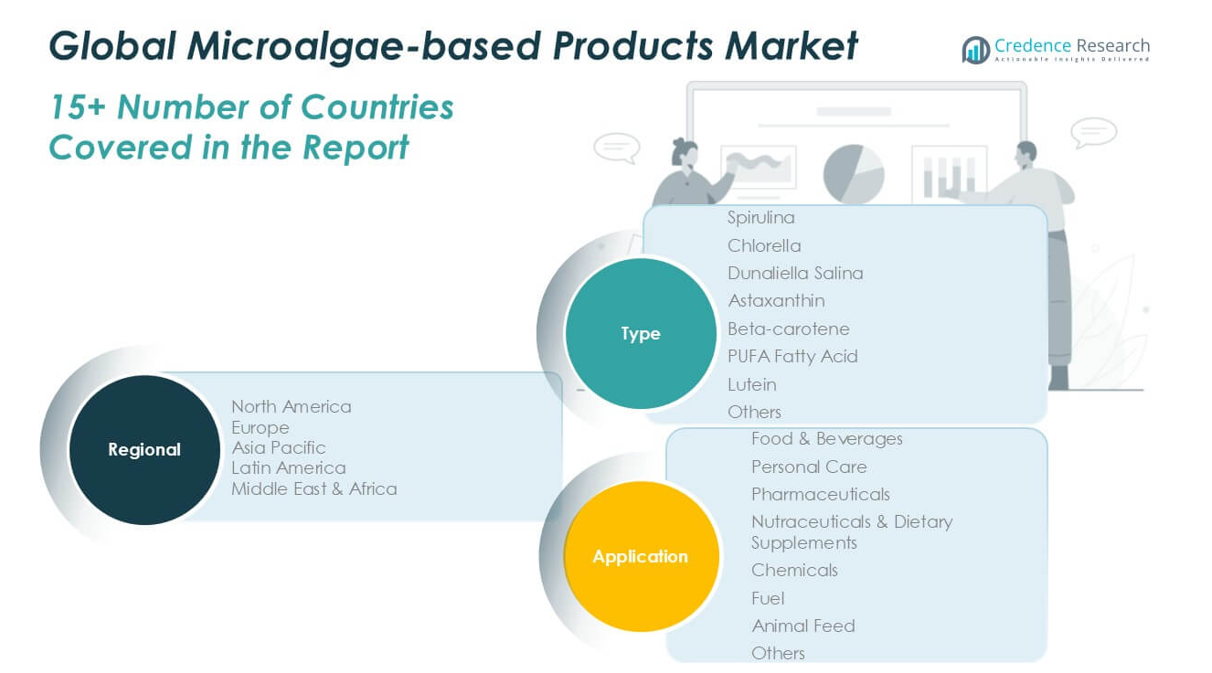CHAPTER NO. 1: GENESIS OF THE MARKET
1.1 Market Prelude – Introduction & Scope
1.2 The Big Picture – Objectives & Vision
1.3 Strategic Edge – Unique Value Proposition
1.4 Stakeholder Compass – Key Beneficiaries
CHAPTER NO. 2: EXECUTIVE LENS
2.1 Pulse of the Industry – Market Snapshot
2.2 Growth Arc – Revenue Projections (USD Million)
2.3. Premium Insights – Based on Primary Interviews
CHAPTER NO. 3: MICROALGAE-BASED PRODUCTS MARKET FORCES & INDUSTRY PULSE
3.1 Foundations of Change – Market Overview
3.2 Catalysts of Expansion – Key Market Drivers
3.2.1 Momentum Boosters – Growth Triggers
3.2.2 Innovation Fuel – Disruptive Technologies
3.3 Headwinds & Crosswinds – Market Restraints
3.3.1 Regulatory Tides – Compliance Challenges
3.3.2 Economic Frictions – Inflationary Pressures
3.4 Untapped Horizons – Growth Potential & Opportunities
3.5 Strategic Navigation – Industry Frameworks
3.5.1 Market Equilibrium – Porter’s Five Forces
3.5.2 Ecosystem Dynamics – Value Chain Analysis
3.5.3 Macro Forces – PESTEL Breakdown
3.6 Price Trend Analysis
3.6.1 Regional Price Trend
3.6.2 Price Trend by product
CHAPTER NO. 4: KEY INVESTMENT EPICENTER
4.1 Regional Goldmines – High-Growth Geographies
4.2 Product Frontiers – Lucrative Product Categories
4.3 Application Sweet Spots – Emerging Demand Segments
CHAPTER NO. 5: REVENUE TRAJECTORY & WEALTH MAPPING
5.1 Momentum Metrics – Forecast & Growth Curves
5.2 Regional Revenue Footprint – Market Share Insights
5.3 Segmental Wealth Flow – Grade & Application Revenue
CHAPTER NO. 6: TRADE & COMMERCE ANALYSIS
6.1.Import Analysis by Region
6.1.1. Global Microalgae-based Products Market Import Volume By Region
6.2.Export Analysis by Region
6.2.1. Global Microalgae-based Products Market Export Volume By Region
CHAPTER NO. 7: COMPETITION ANALYSIS
7.1.Company Market Share Analysis
7.1.1. Global Microalgae-based Products Market: Company Market Share
7.1. Global Microalgae-based Products Market Company Volume Market Share
7.2. Global Microalgae-based Products Market Company Revenue Market Share
7.3.Strategic Developments
7.3.1.Acquisitions & Mergers
7.3.2. New Product Launch
7.3.3. Regional Expansion
7.4. Competitive Dashboard
7.5. Company Assessment Metrics, 2024
CHAPTER NO. 8: MICROALGAE-BASED PRODUCTS MARKET – BY TYPE SEGMENT ANALYSIS
8.1. Microalgae-based Products Market Overview by Type Segment
8.1.1. Microalgae-based Products Market Volume Share By Type
8.1.2. Microalgae-based Products Market Revenue Share By Type
8.2.Spirulina
8.3. Chlorella
8.4. Dunaliella Salina
8.5. Astaxanthin
8.6. Beta-carotene
8.7. PUFA Fatty Acid
8.8. Lutein
8.9. Others
CHAPTER NO. 9: MICROALGAE-BASED PRODUCTS MARKET – BY APPLICATION SEGMENT ANALYSIS
9.1. Microalgae-based Products Market Overview by Application Segment
9.1.1. Microalgae-based Products Market Volume Share By Application
9.1.2. Microalgae-based Products Market Revenue Share By Application
9.2.Food & Beverages
9.3. Personal Care
9.4. Pharmaceuticals
9.5. Nutraceuticals & Dietary Supplements
9.6.Chemicals
9.7. Fuel
9.8. Animal Feed
9.9. Others
CHAPTER NO. 10: MICROALGAE-BASED PRODUCTS MARKET – REGIONAL ANALYSIS
10.1.Microalgae-based Products Market Overview by Region Segment
10.1.1. Global Microalgae-based Products Market Volume Share By Region
10.1.2. Global Microalgae-based Products Market Revenue Share By Region
10.1.3.Regions
10.1.4.Global Microalgae-based Products Market Volume By Region
10.1.5.Global Microalgae-based Products Market Revenue By Region
10.1.6.Grade
10.1.7.Global Microalgae-based Products Market Volume By Grade
10.1.8. Global Microalgae-based Products Market Revenue By Grade
10.1.9.Application
10.1.10. Global Microalgae-based Products Market Volume By Application
10.1.11. Global Microalgae-based Products Market Revenue By Application
CHAPTER NO. 11: NORTH AMERICA MICROALGAE-BASED PRODUCTS MARKET – COUNTRY ANALYSIS
11.1. North America Microalgae-based Products Market Overview by Country Segment
11.1.1.North America Microalgae-based Products Market Volume Share By Region
11.1.2. North America Microalgae-based Products Market Revenue Share By Region
11.2.North America
11.2.1. North America Microalgae-based Products Market Volume By Country
11.2.2. North America Microalgae-based Products Market Revenue By Country
11.2.3.Grade
11.2.4.North America Microalgae-based Products Market Volume By Grade
11.2.5. North America Microalgae-based Products Market Revenue By Grade
11.2.6.Application
11.2.7.North America Microalgae-based Products Market Volume By Application
11.2.8.North America Microalgae-based Products Market Revenue By Application
11.3.U.S.
11.4.Canada
11.5.Mexico
CHAPTER NO. 12: EUROPE MICROALGAE-BASED PRODUCTS MARKET – COUNTRY ANALYSIS
12.1. Europe Microalgae-based Products Market Overview by Country Segment
12.1.1. Europe Microalgae-based Products Market Volume Share By Region
12.1.2. Europe Microalgae-based Products Market Revenue Share By Region
12.2.Europe
12.2.1.Europe Microalgae-based Products Market Volume By Country
12.2.2.Europe Microalgae-based Products Market Revenue By Country
12.2.3.Grade
12.2.4. Europe Microalgae-based Products Market Volume By Grade
12.2.5.Europe Microalgae-based Products Market Revenue By Grade
12.2.6.Application
12.2.7. Europe Microalgae-based Products Market Volume By Application
12.2.8. Europe Microalgae-based Products Market Revenue By Application
12.3.UK
12.4.France
12.5.Germany
12.6.Italy
12.7.Spain
12.8.Russia
12.9. Rest of Europe
CHAPTER NO. 13: ASIA PACIFIC MICROALGAE-BASED PRODUCTS MARKET – COUNTRY ANALYSIS
13.1.Asia Pacific Microalgae-based Products Market Overview by Country Segment
13.1.1. Asia Pacific Microalgae-based Products Market Volume Share By Region
13.1.2.Asia Pacific Microalgae-based Products Market Revenue Share By Region
13.2.Asia Pacific
13.2.1. Asia Pacific Microalgae-based Products Market Volume By Country
13.2.2.Asia Pacific Microalgae-based Products Market Revenue By Country
13.2.3.Grade
13.2.4. Asia Pacific Microalgae-based Products Market Volume By Grade
13.2.5.Asia Pacific Microalgae-based Products Market Revenue By Grade
13.2.6.Application
13.2.7. Asia Pacific Microalgae-based Products Market Volume By Application
13.2.8. Asia Pacific Microalgae-based Products Market Revenue By Application
13.3.China
13.4.Japan
13.5.South Korea
13.6.India
13.7.Australia
13.8.Southeast Asia
13.9. Rest of Asia Pacific
CHAPTER NO. 14: LATIN AMERICA MICROALGAE-BASED PRODUCTS MARKET – COUNTRY ANALYSIS
14.1. Latin America Microalgae-based Products Market Overview by Country Segment
14.1.1.Latin America Microalgae-based Products Market Volume Share By Region
14.1.2.Latin America Microalgae-based Products Market Revenue Share By Region
14.2. Latin America
14.2.1. Latin America Microalgae-based Products Market Volume By Country
14.2.2. Latin America Microalgae-based Products Market Revenue By Country
14.2.3.Grade
14.2.4. Latin America Microalgae-based Products Market Volume By Grade
14.2.5. Latin America Microalgae-based Products Market Revenue By Grade
14.2.6.Application
14.2.7.Latin America Microalgae-based Products Market Volume By Application
14.2.8.Latin America Microalgae-based Products Market Revenue By Application
14.3.Brazil
14.4.Argentina
14.5.Rest of Latin America
CHAPTER NO. 15: MIDDLE EAST MICROALGAE-BASED PRODUCTS MARKET – COUNTRY ANALYSIS
15.1. Middle East Microalgae-based Products Market Overview by Country Segment
15.1.1.Middle East Microalgae-based Products Market Volume Share By Region
15.1.2. Middle East Microalgae-based Products Market Revenue Share By Region
15.2.Middle East
15.2.1. Middle East Microalgae-based Products Market Volume By Country
15.2.2. Middle East Microalgae-based Products Market Revenue By Country
15.2.3.Grade
15.2.4.Middle East Microalgae-based Products Market Volume By Grade
15.2.5.Middle East Microalgae-based Products Market Revenue By Grade
15.2.6.Application
15.2.7. Middle East Microalgae-based Products Market Volume By Application
15.2.8. Middle East Microalgae-based Products Market Revenue By Application
15.3.GCC Countries
15.4. Israel
15.5. Turkey
15.6.Rest of Middle East
CHAPTER NO. 16: AFRICA MICROALGAE-BASED PRODUCTS MARKET – COUNTRY ANALYSIS
16.1. Africa Microalgae-based Products Market Overview by Country Segment
16.1.1.Africa Microalgae-based Products Market Volume Share By Region
16.1.2. Africa Microalgae-based Products Market Revenue Share By Region
16.2. Africa
16.2.1.Africa Microalgae-based Products Market Volume By Country
16.2.2.Africa Microalgae-based Products Market Revenue By Country
16.2.3.Grade
16.2.4.Africa Microalgae-based Products Market Volume By Grade
16.2.5.Africa Microalgae-based Products Market Revenue By Grade
16.2.6.Application
16.2.7. Africa Microalgae-based Products Market Volume By Application
16.2.8. Africa Microalgae-based Products Market Revenue By Application
16.3. South Africa
16.4.Egypt
16.5.Rest of Africa
CHAPTER NO. 17: COMPANY PROFILES
17.1.Cyanotech Corporation
17.1.1.Company Overview
17.1.2.Product Portfolio
17.1.3.Financial Overview
17.1.4.Recent Developments
17.1.5.Growth Strategy
17.1.6.SWOT Analysis
17.2.Corbion N.V.
17.3.E.I.D. Parry (Parry Nutraceuticals)
17.4.Far East Bio-Tec (FEBICO)
17.5.Fuqing King Dnarmsa Spirulina
17.6.DIC Corporation (Earthrise Nutritionals)
17.7.DSM-Firmenich
17.8.BASF SE
17.9. Cargill, Inc.
17.10.AlgaeEnergy S.A.
17.11.Algaetechologies (Solabia Group)
17.12. Cellana, Inc.
17.13. Algenol Biotech
17.14. Bluetec Naturals









